Hunger
 The power of physiological needs to hijack our minds was vividly demonstrated when Ancel Keys and his research team (1950) did a now-classic study. First, they fed 36 male volunteers just enough to maintain their initial weight. Then, for six months, they cut this food level in half. The effects soon became visible. Without thinking about it, the men began conserving energy. They appeared sluggish and dull. After dropping rapidly, their body weights stabilized at about 25 percent below their starting point.
The power of physiological needs to hijack our minds was vividly demonstrated when Ancel Keys and his research team (1950) did a now-classic study. First, they fed 36 male volunteers just enough to maintain their initial weight. Then, for six months, they cut this food level in half. The effects soon became visible. Without thinking about it, the men began conserving energy. They appeared sluggish and dull. After dropping rapidly, their body weights stabilized at about 25 percent below their starting point.
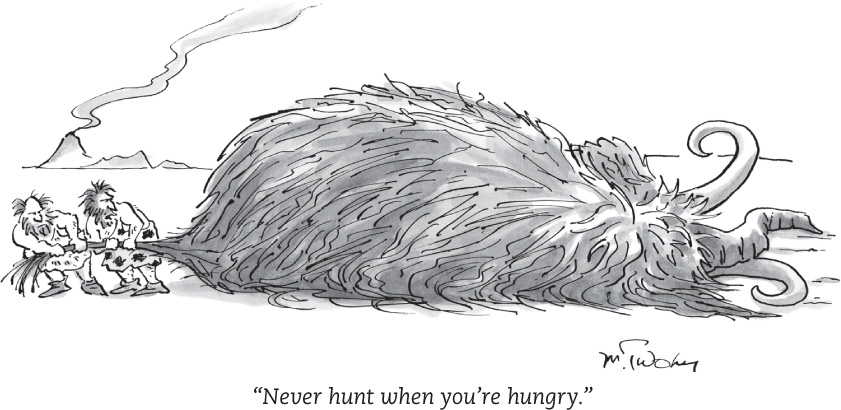
As Maslow might have guessed, the men became obsessed with food. They talked about it. They daydreamed about it. They collected recipes, read cookbooks, and feasted their eyes on tasty but forbidden food. Focused on their unmet basic need, they lost interest in sex and social activities. One man reported, “If we see a show, the most interesting [parts are] scenes where people are eating. I couldn’t laugh at the funniest picture in the world, and love scenes are completely dull.” As journalist Dorothy Dix (1861–1951) observed, “Nobody wants to kiss when they are hungry.”
Motives can capture our consciousness. When we’re hungry, thirsty, fatigued, or sexually aroused, little else seems to matter. When we’re not, food, water, sleep, or sex just don’t seem like such big things in life, now or ever. (You may recall from Chapter 7 a parallel effect of our current good or bad mood on our memories.) Shop for food on an empty stomach and you are more likely to see those jelly-filled doughnuts as just what you’ve always loved and will be wanting tomorrow. Motives matter mightily.
The Physiology of Hunger
9-2 What physiological factors cause us to feel hungry?
Deprived of a normal food supply, Keys’ volunteers were clearly hungry. What triggers hunger? Does it arise from the pangs of an empty stomach? So it seemed to A. L. Washburn. Working with Walter Cannon (Cannon & Washburn, 1912), Washburn agreed to swallow a balloon that was attached to a recording device (FIGURE 9.4). When inflated to fill his stomach, the balloon tracked his stomach contractions. Washburn supplied information about his feelings of hunger by pressing a key each time he felt a hunger pang. The discovery: When Washburn felt hungry, he was indeed having stomach contractions.
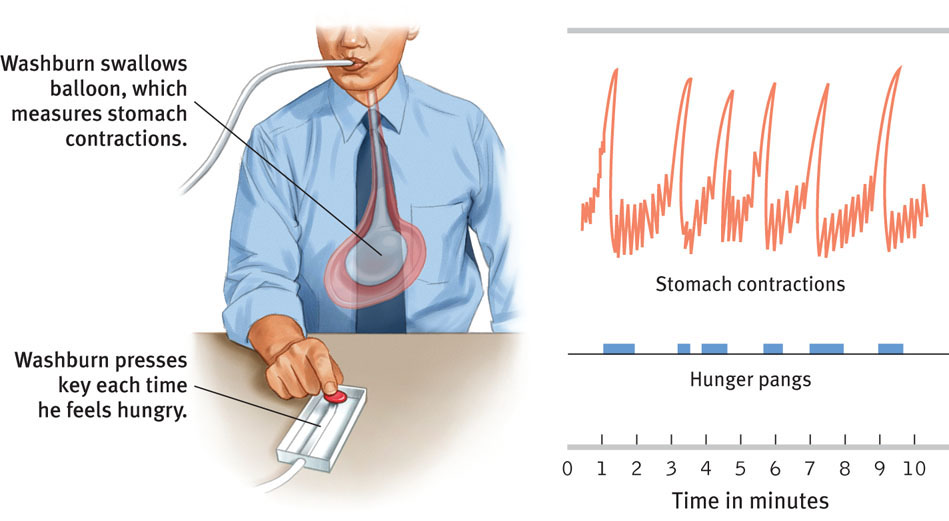
Can hunger exist without stomach pangs? To answer that question, researchers removed some rats’ stomachs and created a direct path to their small intestines (Tsang, 1938). Did the rats continue to eat? Indeed they did. Some hunger persists similarly in humans whose stomachs have been removed as a treatment for ulcers or cancer. So the pangs of an empty stomach cannot be the only source of hunger. What else might trigger hunger?
Body Chemistry and the Brain
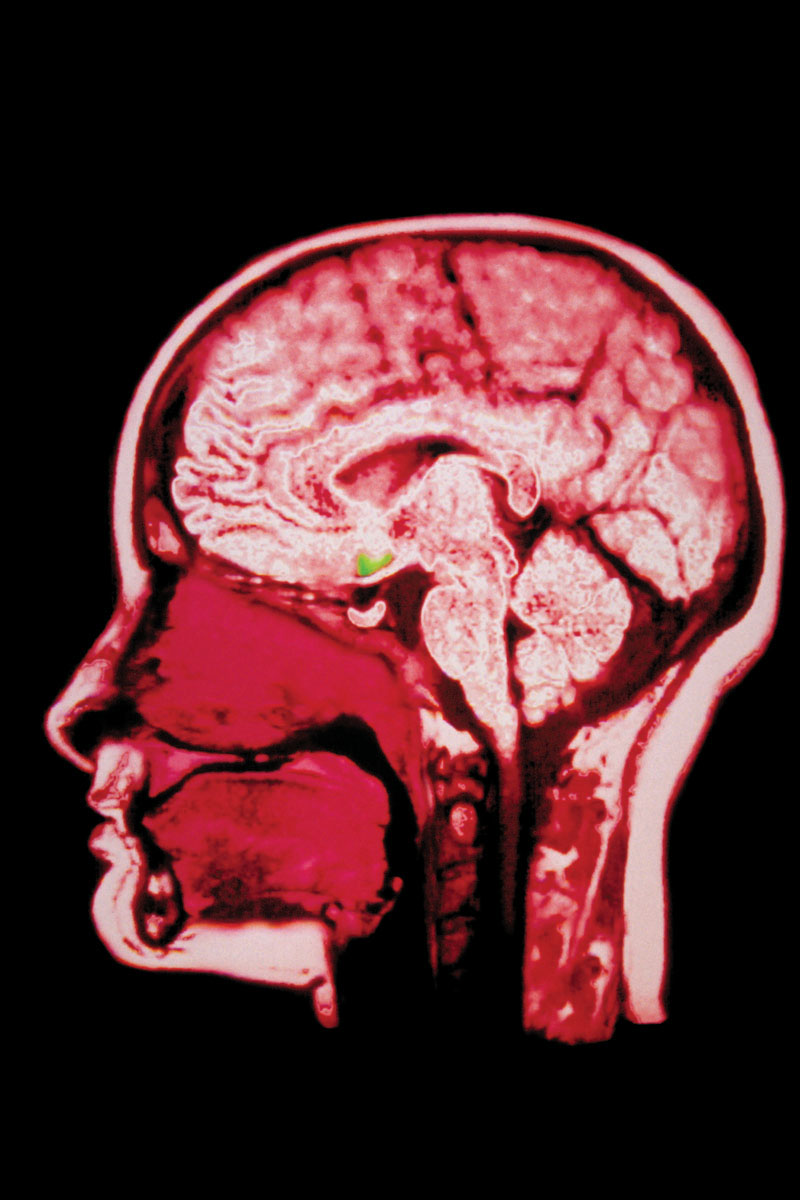
Somehow, somewhere, your body is keeping tabs on the energy it takes in and the energy it uses. This balancing act enables you to maintain a stable body weight. A major source of energy in your body is the glucose circulating in your bloodstream. If your blood glucose level drops, you won’t consciously feel this change. But your brain, which automatically monitors your blood chemistry and your body’s internal state, will trigger your feeling of hunger.
How does the brain sound the alarm? The work is done by several neural areas, some housed deep in the brain within the hypothalamus (FIGURE 9.5). This neural traffic intersection includes areas that influence eating. In one neural area (called the arcuate nucleus), a center pumps out appetite-stimulating hormones, and another center pumps out appetite-suppressing hormones. When researchers stimulate an appetite-enhancing center in this or another neural area, well-fed animals will begin to eat. If they destroy the area, even starving animals lose interest in food. The opposite occurs when the appetite-suppressing area is stimulated: The animal will stop eating. Destroy this area and animals become extremely fat (Duggan & Booth, 1986; Hoebel & Teitelbaum, 1966) (FIGURE 9.6).

259
Blood vessels connect the hypothalamus to the rest of the body, so it can respond to our current blood chemistry and other incoming information. One of its tasks is monitoring levels of appetite hormones, such as ghrelin, a hunger-arousing hormone secreted by an empty stomach. When people have surgery for severe obesity, surgeons seal off part of the stomach. The remaining stomach then produces much less ghrelin, and the person’s appetite lessens (Lemonick, 2002). Other appetite hormones include insulin, leptin, orexin, and PYY. FIGURE 9.7 describes how they influence your feelings of hunger.
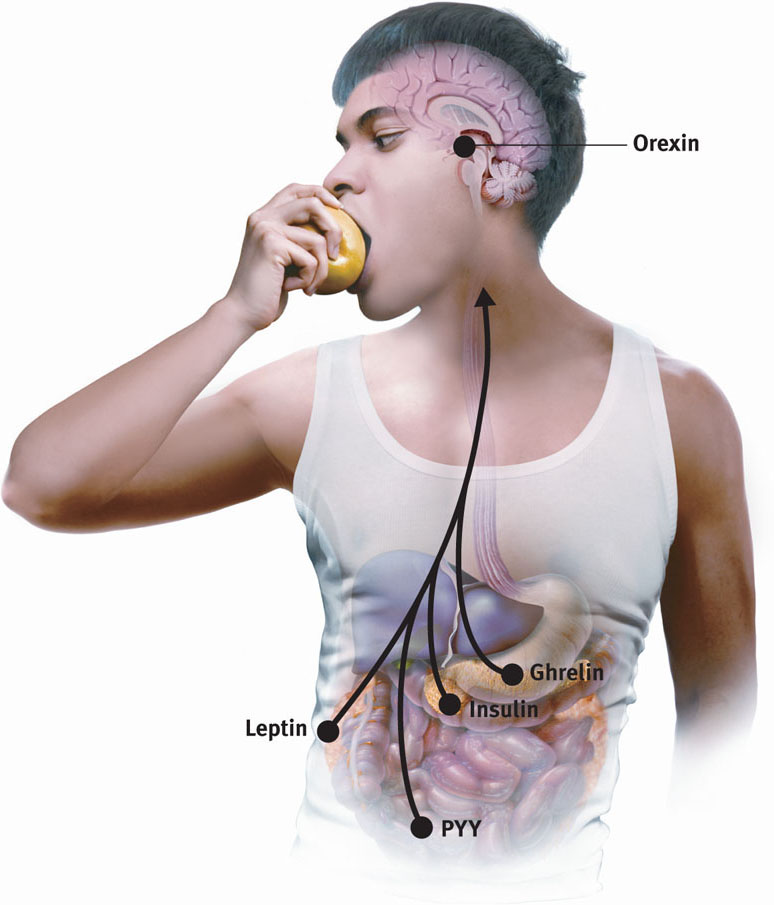
Insulin: Hormone secreted by pancreas; controls blood glucose.
Leptin: Protein hormone secreted by fat cells; when abundant, causes brain to increase metabolism and decrease hunger.
Orexin: Hunger-triggering hormone secreted by hypothalamus.
PYY: Digestive tract hormone; sends “I’m not hungry” signals to the brain.
The interaction of appetite hormones and brain activity suggests that the body has a “weight thermostat.” When semistarved rats fall below their normal weight, this system signals their bodies to restore the lost weight: Their hunger increases and their energy output decreases. If body weight rises—as happens when rats are force-fed—hunger decreases and energy output increases. In this way, rats (and humans) tend to hover around a stable weight, or set point, influenced in part by heredity (Keesey & Corbett, 1983).
We humans (and other species, too) vary in our basal metabolic rate, a measure of how much energy we use to maintain basic body functions when our body is at rest. But we share a common response to decreased food intake: our basal metabolic rate drops. So it did for the participants in Keys’ experiment. After 24 weeks of semistarvation, they stabilized at three-quarters of their normal weight, although they were taking in only half their previous calories. How did their bodies achieve this dieter’s nightmare? They reduced the amount of energy they were using—partly by being less active, but partly by dropping their basal metabolic rate by 29 percent.
260
Some researchers have suggested that the idea of a biologically fixed set point is too rigid to explain why slow, steady changes in body weight can alter a person’s set point (Assanand et al., 1998), or why, when we have unlimited access to various tasty foods, we tend to overeat and gain weight (Raynor & Epstein, 2001). Thus, some researchers prefer the looser term settling point to indicate the level at which a person’s weight settles in response to caloric intake and energy use. As we will see next, environment matters as well as biology.
RETRIEVE + REMEMBER
Question 9.4
Hunger occurs in response to ________________ (low/high) blood glucose and ________________ (low/high) levels of ghrelin.
low; high
The Psychology of Hunger

9-3 How do psychological, biological, cultural, and situational factors affect our taste preferences and eating habits?
We have seen that our eagerness to eat is pushed by our body chemistry and brain activity. Yet there is more to hunger than meets the stomach. This was strikingly apparent when trickster researchers tested two patients who had no memory for events occurring more than a minute ago (Rozin et al., 1998). If offered a second lunch 20 minutes after eating a normal lunch, both patients readily ate it…and usually a third meal offered 20 minutes after they finished the second. This suggests that one part of our decision to eat is our memory of the time of our last meal. As time passes, we think about eating again, and that thought triggers feelings of hunger.
Psychological influences on eating behavior affect all of us at some point. But consider this: Over the next 40 years you will eat about 20 tons of food. If during those years you give in to the environmental stimuli bombarding you, and you increase your daily intake by just .01 ounce more than required for your energy needs, you will gain 24 pounds (Martin et al., 1991).
Taste Preferences: Biology and Culture
Both body chemistry and environment play a role in our feelings of hunger and in what we hunger for—our taste preferences. When feeling tense or depressed, do you crave starchy, carbohydrate-laden foods? High-carb foods, such as pasta, chips, and sweets, help boost levels of the neurotransmitter serotonin, which has calming effects. When stressed, even rats find it extra rewarding to scarf Oreos (Artiga et al., 2007; Boggiano et al., 2005).
261
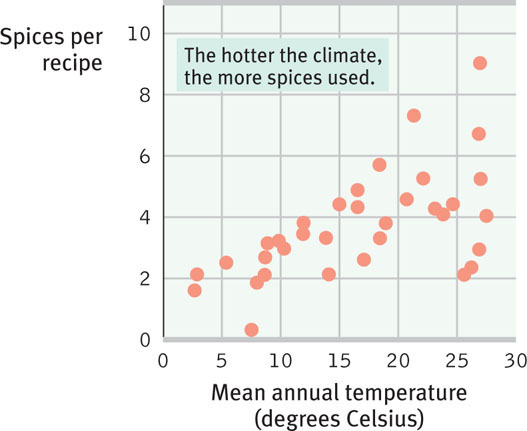
Our preferences for sweet and salty tastes are genetic and universal. Other taste preferences are learned. People given highly salted foods, for example, develop a liking for excess salt (Beauchamp, 1987). People who become violently ill after eating a particular food often develop a dislike of it. (The frequency of children’s illnesses provides many chances for them to learn to avoid certain foods.)
Our culture teaches us that some foods are acceptable but others are not. Bedouins enjoy eating the eye of a camel, which most North Americans would find repulsive. North Americans and Europeans also shun horse, dog, and rat meat, all of which are prized elsewhere.
We also may learn to prefer some tastes because they are adaptive. In hot climates (where food spoils more quickly), recipes often include spices that slow the growth of bacteria (FIGURE 9.8). India averages nearly 10 spices per meat recipe, Finland 2 spices. Pregnancy-related food dislikes—and the nausea associated with them—are another example of adaptive taste preferences. These dislikes peak about the tenth week, when the developing embryo is most vulnerable to toxins.
Rats tend to avoid unfamiliar foods (Sclafani, 1995). So do we, especially those that are animal-based. This surely was adaptive for our ancestors by protecting them from potentially toxic substances.
Tempting Situations
Would it surprise you to know that situations also control your eating? Psychologists call this effect the ecology of eating.
Friends and food Do you eat more when eating with others? Most of us do (Herman et al., 2003; Hetherington et al., 2006). The presence of others tends to amplify our natural behavior tendencies. (This is social facilitation and you’ll hear more about it in Chapter 12.)
Serving size is significant French waistlines are smaller than American waistlines. From soda drinks to yogurt sizes, the French offer foods in smaller portion sizes. Does it matter? (One could as well order two small sandwiches as one large one.) To find out, researchers offered people varieties of free snacks (Geier et al., 2006). For example, in the lobby of an apartment house, they laid out either full or half pretzels, big or little Tootsie Rolls, or a big bowl of M&M’s with either a small or large serving scoop. Their consistent result: Offered a supersized portion, people put away more calories. Other studies confirm that we eat more when given supersized servings, bigger food packages, and larger serving containers (Herman & Polivy, 2008; Wansink, 2007). Offered pasta, people eat more when given a big plate (Van Ittersum & Wansink, 2012). Offered ice cream, people take and eat more when given a big bowl and big scoop. They pour and drink more from short, wide glasses than from tall, narrow glasses. And they take more of easier-to-reach foods on buffet lines (Marteau et al., 2012). Portion size matters.
Selections stimulate Food variety promotes eating. Offered a dessert buffet, we eat more than we do when choosing a portion from one favorite dessert. For our early ancestors, eating more when foods were abundant and varied was adaptive. Consuming a wide range of vitamins and minerals and storing fat offered protection later, during winter cold or famine. When bad times hit, they could eat less, hoarding their small food supply until winter or famine ended (Polivy et al., 2008; Remick et al., 2009).

RETRIEVE + REMEMBER
Question 9.5
After an eight-hour hike without food, your long-awaited favorite dish is placed in front of you, and your mouth waters in anticipation. Why?
You have learned to respond to the sight and aroma that signal the food about to enter your mouth. Both physiological cues (low blood sugar) and psychological cues (anticipation of the tasty meal) heighten your experienced hunger.
Obesity and Weight Control
9-4 What factors predispose some people to become and remain obese?
Obesity has physical health risks, but it can also be socially toxic, by affecting both how you feel about yourself and how others treat you. Obese 6- to 9-year olds are 60 percent more likely to suffer bullying (Lumeng et al., 2010). Adult obesity is linked with lower psychological well-being, increased depression, and discrimination in employment (de Wit et al., 2010; Luppino et al., 2010; Mendes, 2010; Roehling et al., 1999, 2009, 2010). Yet few overweight people win the battle of the bulge. Why? And why do some people gain weight while others eat the same amount and seldom add a pound?
The Survival Value—and Health Risks—of Fat
The answers lie partly in our history. Fat is stored energy. It is a fuel reserve that can carry us through times when food is scarce, which were common in our prehistoric ancestors’ world. (Think of that spare tire around the middle as an energy storehouse—biology’s counter-part to a hiker’s waist-borne snack pack.) In Europe in earlier centuries, and in parts of the world today, obesity signaled wealth and social status (Furnham & Baguma, 1994).
262
Our hungry distant ancestors were well served by a simple rule: When you find energy-rich fat or sugar, eat it! That rule is no longer adaptive in a world where food and sweets are abundantly available. Pretty much everywhere this book is being read, people have a growing problem. Worldwide, obesity has doubled since 1980, with 1.46 billion adults now overweight. Some 502 million are obese, which is defined as a body mass index (BMI) of 30 or more (Swinburn et al., 2011). (See cdc.gov/healthyweight/assessing/bmi to calculate your BMI.) In the United States, 36 percent of adults are now obese (Flegal et al., 2012).

Significant obesity can shorten your life, reduce your quality of life, and increase your health care costs (de Gonzales et al., 2010; Jarrett et al., 2010; Sun, 2009). It increases the risk of diabetes, high blood pressure, heart disease, gallstones, arthritis, and certain types of cancer. Women’s obesity has been linked to a higher risk of late-life cognitive decline, including Alzheimer’s disease and brain tissue loss (Bruce-Keller et al., 2009; Whitmer et al., 2008). In one experiment, memory performance improved 12 weeks after severely obese people had weight-loss surgery and lost significant weight. Those not having the surgery showed some further cognitive decline (Gunstad et al., 2011).
So why don’t obese people just drop that excess baggage? Because their bodies fight back.
A SLUGGISH METABOLISM Once we become fat, we require less food to maintain our weight than we did to gain it. Compared with muscle tissue, fat has a lower metabolic rate—it takes less food energy to maintain. When an overweight person’s body drops below its previous set (or settling) point, the person’s hunger increases and metabolism decreases. Thus, the body adapts to starvation by burning off fewer calories.
Lean people and overweight people differ in their rates of resting metabolism. Lean people seem naturally disposed to move about, and in doing so, they burn more calories. Overweight people tend to sit still longer and conserve their energy (Levine et al., 2005). This helps explain why two people of the same height and age can maintain the same weight, even if one of them eats much more than the other does. (Who said life is fair?)
A GENETIC HANDICAP It’s true: Our genes influence the size of our jeans. Consider:
- Adopted children share meals with their adoptive siblings and parents. Yet their body weights more closely resemble those of their biological family (Grilo & Pogue-Geile, 1991).
- Identical twins have closely similar weights, even when raised apart (Plomin et al., 1997; Stunkard et al., 1990). Fraternal twins’ weights are much less similar. Such findings suggest that genes explain two-thirds of the person-to-person differences in body mass (Maes et al., 1997).
SLEEP, FRIENDS, FOOD, ACTIVITY—THEY ALL MATTER! Genes tell an important part of the obesity story. But environmental factors are mighty important, too.
Studies in Europe, Japan, and the United States show that children and adults who suffer from sleep loss are more at risk for obesity (Keith et al., 2006; Nedeltcheva et al., 2010; Taheri, 2004a,b). Deprived of sleep, our bodies produce less leptin (which reports body fat to the brain) and more ghrelin (the appetite-stimulating stomach hormone).
Social influence is another factor. One 32-year study of 12,067 people found them most likely to become obese when a friend became obese (Christakis & Fowler, 2007). The odds of becoming obese almost tripled when the obese friend was a close one. Moreover, the correlation among friends’ weights was not simply a matter of seeking out similar people as friends.
Friends matter, but the strongest evidence that environment influences weight comes from our fattening world (FIGURE 9.9). What explains this growing problem? Changing food consumption and activity levels are at work. Our lifestyles now approach those of animal feedlots, where farmers fatten animals by giving them lots of food and little exercise. That works for humans, too. We are eating more and moving less. In the United States, jobs requiring moderate physical activity declined from about 50 percent in 1960 to 20 percent in 2011 (Church et al., 2011).
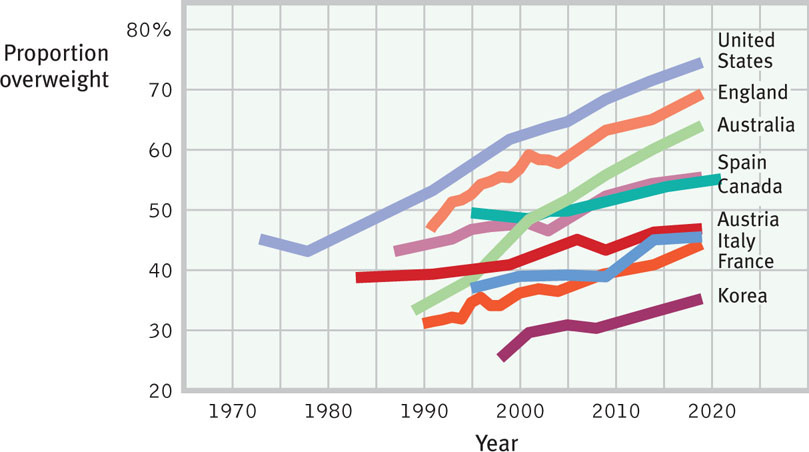
Stadiums, theaters, and subway cars—but not airplanes—are widening seats to accommodate the new “bottom” line (Hampson, 2000; Kim & Tong, 2010). Washington State Ferries abandoned a 50-year-old standard: “Eighteen-inch butts are a thing of the past” (Shepherd, 1999). New York City, facing a large problem with Big Apple bottoms, has mostly replaced 17.5-inch bucket-style subway seats with bucketless seats (Hampson, 2000). In the end, today’s people need more room.
* * *
263
The obesity research findings reinforce a familiar lesson from Chapter 8’s study of intelligence. There can be high levels of heritability (genetic influence on individual differences) without heredity being the only explanation of group differences. Genes mostly determine why you are heavier or leaner than your friends. Environment mostly determines why you and your friends are heavier than your parents and grandparents were at your age.
Our eating behavior once again demonstrates one of this book’s big ideas: Biological, psychological, and social-cultural factors interact. We have seen many biological and psychological forces working against those who want to shed excess pounds. Indeed, short of drastic surgery to tie off part of the stomach and small intestine, most who have succeeded on weight-loss programs have eventually regained most of the weight (Mann et al., 2007).
Setting Realistic Goals
Nearly two-thirds of American women and half of American men have said that they want to lose weight. About half of those people have said they are “seriously trying” (Moore, 2006).
So what advice can psychology offer? Permanent weight loss is not easy. For some helpful hints, see Close-Up: Waist Management. 
RETRIEVE + REMEMBER
Question 9.6
Why can two people of the same height, age, and activity level maintain the same weight, even if one of them eats much less than the other does?
Individuals have very different set points and genetically influenced metabolism levels, causing them to burn calories differently.